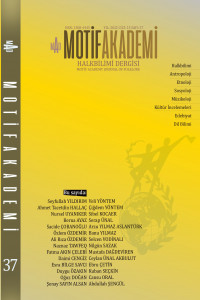BABA YAGA: RUS FOLKLORUNDA CADI VE ANNE ARKETİPİ BAĞLAMINDA YAŞLANAN KADIN BEDENİNİN ŞEYTANLAŞTIRILMASI
BABA YAGA: THE WITCH IN RUSSIAN FOLKLORE AND DEMONIZATION OF THE AGING FEMALE BODY WITHIN THE CONTEXT OF MOTHER ARCHETYPE
Author(s): Duygu ÖzakınSubject(s): Gender Studies, Customs / Folklore, Russian Literature, Gerontology
Published by: Motif Halk Oyunları Eğitim ve Öğretim Vakfı
Keywords: Baba Yaga; witch hunt; feminist revisionist mythology; female body; ageism;
Summary/Abstract: This study evaluates corporeal representations of Baba Yaga as a negative reflection of the mother archetype in Russian folklore through feminist revisionist mythology. Punitive, retributive and merciless heroines often appear as a “witch” or a malicious woman contrary to the image of nurturing, protective and affectionate mother. According to these uncanny, ambiguous, dual features the female heroines are described as frightening beings not only by their actions but also by their physical appearance. In Russian folklore, the witch prototype corresponds to an old female figure called Baba Yaga. The ambivalent nature of Baba Yaga, which combines benevolent and threatening qualities, has been the most noticeable feature of her for folklorists. Baba Yaga lives alone in her hut surrounded by skulls and bones in the depths of the dark forest and lives independently, far from the pressure and control mechanisms of the patriarchal value system. Often portrayed as a childless woman, who lives alone, Baba Yaga is depicted with pejorative qualities such as “old”, “dried”, “ugly” or “wicked” in addition to the emphasis on her uncanny nature. The predominance of the malevolent qualities attributed to her makes the positive functions in the initiation ceromony obscure, and Baba Yaga became a symbol of fear and insult due to the grotesque nature of her corporeal qualities. This study examines the linearities between the demonic qualities attributed to women, who have been accused of being witches throughout history and the characteristics of Baba Yaga through feminist revisionist mythology. The study discusses that when the female body is identified with fertile soil, its positive reflections are highlighted and the body is associated with moisture and abundance. However, when the female body loses fertility and moisture, its archetypically negative reflections begin to be emphasized more and the body is associated with demonic powers.
Journal: Motif Akademi Halkbilimi Dergisi
- Issue Year: 15/2022
- Issue No: 37
- Page Range: 151-165
- Page Count: 15
- Language: Turkish

